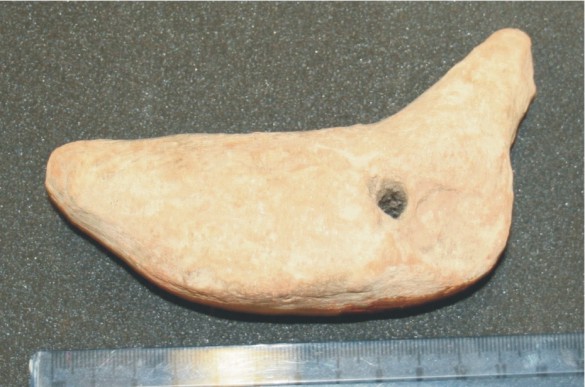EC25

This roughly made pottery bird is approximately 12cm long. Its head is missing and there is a hole through the middle.
Pottery items like these have been found at numerous sites in Egypt and Nubia such as Amarna (Pendlebury 1951 I, 142 36/155; II, pl. 84), Mirgissa, Lahun and Askut. Those found at Lahun and Mirgissa are dated to the Middle Kingdom (2025-1750 BC), and those from Amarna date to the New Kingdom. Examples have also been found dating to the Roman Period including a wooden example from Hawara.
It has been suggested that these pottery birds were used as children’s toys, with sticks or pottery wheels being inserted into the hole to allow movement. There is much evidence for the use of clay and mud to make toy animals, including crocodiles, hippopotami and monkeys. Roughly made unfired clay items were found at the domestic settlement of Lahun, which suggests that those particular examples were used as children’s toys. The Amarna example was found in the Pavilion of a house. Clay would have been the perfect material for making children’s toys as it is commonly occurring and basically free to source. Teeter (2010, 144) states that on Roman stelae toy birds were a symbol of innocence, and Török (1993, 53) states that clay toy birds were a popular children’s toy throughout the ancient world. The Centre also has a stone sculpture showing a boy with a bird (W1161).
There are many problems that arise from objects like this, whilst they can be interpreted as toys for children, the ancient Egyptians also used models in human and animal form as votive offerings to the gods. Often it is the context in which items were found that give an idea of the function of the piece.
There could have been religious significance to the clay animals found throughout ancient Egypt, as animals like crocodiles and hippopotami where very dangerous creatures to the ancient Egyptians and greatly feared, but they are also associated with gods. Many clay votive animals have been found in Middle Kingdom fort sites such as Buhen, as well as at shrines dedicated to Hathor.
The choice of a bird is not unusual for ancient Egypt, many species of birds lived or migrated via Egypt, and the various species can be seen in many forms from mummified birds to depictions on tomb walls. Birds were used as a food source and pastimes such as hunting birds in marshes is well attested in ancient Egypt. Birds were also linked with the religious world with many gods and goddesses taking bird forms, such as Horus, Isis and Nephthys. It is therefore not surprising that birds were chosen as models for children’s toys or even as votive offerings.
More birds in the Egypt Centre
Bibliography and Further Reading:
David, A.R. (1979) ‘Toys and Games from Kahun in the Manchester Museum Collection’ in Glimpses of Ancient Egypt: Studies in Honour of H.W. Fairman. Ed by John Ruffle et al. Warminster: Aris and Phillips Ltd. 12-15.
Houlihan, P.F. (2001) ‘Birds’ in The Oxford Encyclopaedia of Ancient Egypt, Vol 1. Ed. by D.B. Redford. Oxford: Oxford University Press. 189-191.
Pendlebury, J.D.S. (1951) The City Of Akhenaten Part III. The Central City and the Official Quarters. 2 volumes. London: Egypt Exploration Society.
Teeter, E. 2010. Baked Clay Figurines and Votive Beds from Medinet Habu. Chigaco: The Oriental Institute of the University of Chicago.
Török, L. 1993. Coptic Antiquities.Volume 1. Stone Sculpture, Bronze Objects, Ceramic Coffin Lids and Vessels, Terracotta Statuettes, Bone, Wood and Glass Artefacts. Monumenta antiquitatis extra fines Hungariae reperta 2. Rome: “L’Erma” di Bretschneider.
Tyldesley, J. (2007) Egyptian Games and Sports. Buckinghamshire: Shire Egyptology.